NCERT Summary: Is Matter Around Us Pure | Science & Technology for UPSC CSE PDF Download
| Table of contents |

|
| Introduction |

|
| What Is a Mixture? |

|
| What is a Solution? |

|
| What is a Suspension? |

|
| What is a Colloidal solution? |

|
| Physical and Chemical changes |

|
| What are the Types of Pure Substances? |

|
| Mixture |

|
Introduction
- Word ‘Pure’ on Packs: Have you ever seen the word ‘pure’ on the packages of milk, ghee, butter, salt, spices, mineral water, or juice? What does it mean to you?
- Common Person vs. Scientist: For a common person, ‘pure’ means something that has no adulteration or is not mixed with anything harmful. But for a scientist, these items are actually mixtures of different substances. For example, milk is a mixture of water, fat, proteins, and other components.
- Definition of Pure Substance: When scientists talk about something being pure, they mean that all the particles in that substance are the same in their chemical nature. A pure substance consists of a single type of particle. In simple terms, it’s a single form of matter without any mixture.
- Mixtures Around Us: Most of the matter we see around us is a mixture of two or more pure components. For instance, sea water, minerals, and soil are all mixtures.
What Is a Mixture?
Mixtures are constituted by more than one kind of pure form of matter, known as a substance. For example, sea water, minerals, soil etc., are all mixtures.
- When we say that something is pure, it means that all the constituent particles of that substance are the same in their chemical nature. A pure substance always consists of a single type of particles.
- When we look around, we can see that most of the matter around us exist as mixtures of two or more pure components.
 Examples of Mixtures
Examples of Mixtures
- Dissolved sodium chloride can be separated from water by the physical process of evaporation but sodium chloride cannot be separated into sodium and chlorine by physical means.
Types of mixtures

Depending upon the nature of components that form a mixture, we can have different types of mixtures.
- Homogeneous mixtures: Mixtures which have a uniform composition throughout, are called homogeneous mixtures. For example, salt in water and sugar in water.
- Heterogeneous mixtures: Mixtures which contain physically distinct parts and have non-uniform composition are called heterogeneous mixtures. For example, mixture of sodium chloride and iron filings, salt and sulphur.
Activity: Perform an activity to differentiate between solution, suspension and colloidal solution.
Procedure:
- Distribute the following samples to four groups A, B, C and D of a class.
- A few crystals of copper sulphate to group A.
- One spatula is full of copper sulphate to group B.
- Chalk powder to group C.
- A few drops of milk or ink to group D.
- Ask each group to add the sample to water and stir using a glass rod.
- Direct a beam of light from a torch through the beakers.
- Leave the mixture undisturbed for a few minutes.
- Filter the mixtures

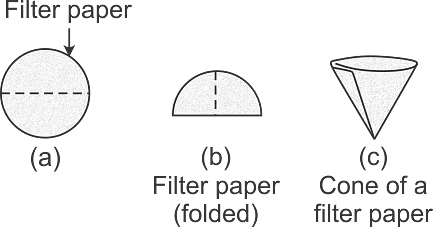 Solution, Suspension and Colloidal Solution
Solution, Suspension and Colloidal Solution
Observations:
- We observe that groups A and B get a clear solution of copper sulphate although with different colour density.
- Group C get a suspension of chalk, which on filtration gives a residue of chalk on the filter paper and clear filtrate containing water.
- Group D get a colloidal solution of milk. The solution in this case is not transparent. But no suspension is obtained here and on filtration, no residue is obtained on the filter paper.
Conclusion:
- Group A and B created homogeneous mixtures with uniform composition, while Groups C and D made heterogeneous mixtures with distinct parts.
- This activity illustrates the difference between homogeneous and heterogeneous mixtures based on composition and appearance.
What is a Solution?
A solution is a homogeneous mixture of two or more substances. Lemonade and soda water are example of solutions.

A solution is not necessarily a liquid containing a solid, liquid or gas dissolved in it. Solid solution (alloys) and gaseous solution are also possible.
Alloys
Alloys are homogeneous mixtures of metals and cannot be separated into their components by physical methods. For example, brass is a mixture of approximately 30% zinc and 70% copper.

Solvent and solute
Solvent and solute are the components of the solution.
- Solvent: The component that dissolves the other component in it is the solvent.
- Solute: The component that is dissolved in the solvent is called solute.
For example, Tincture of iodine is a solution of iodine in alcohol. Aerated drinks like soda water are solutions of carbon dioxide as solute and water as solvent. Air is a mixture of a gas in a gas. The two major components of air are nitrogen (78%) and oxygen (21%).
Note: Generally solute is present in smaller quantity and solvent is present in greater quantity. For example, we have a solution of sugar in water in which case sugar is solute and water is the solvent.
Properties of a solution
- A solution is a homogeneous mixture.
- Particles of a solution are smaller than 1 nm (10-9metre) in diameter. Therefore, they cannot be seen by naked eye.
- Because of small size, they do not scatter light.
- Solute particles cannot be separated from the mixture by filtration.
Concentration of the solution
Concentration of a solution is the amount of solute present in a given amount (mass or volume) of solution.
- A concentrated solution contains a large concentration of the solute in the solvent while a dilute solution contains a small concentration of the solute in the solvent.
- Mass by mass percentage of a solution

- Mass by volume percentage of a solution

Saturated solution
At any particular temperature, a solution that has dissolved as much solute as it is capable of dissolving, is called saturated solution.
No more solute can be dissolved in the saturated solution at a given temperature.
Solubility: The amount of solute present in a saturated solution at a given temperature is called its solubility

Unsaturated solution
If the amount of solute contained in a solution is less than saturation level, it is called unsaturated solution.
Different substances in a given solvent have different solubilities at the same temperature.

What is a Suspension?
A suspension is a heterogeneous mixture in which the solute particles do not dissolve but remain suspended throughout the bulk of medium.
- Particles of a suspension are visible to the naked eye.
- For example, chalk powder in water.
Properties of a suspension
- Suspension is a heterogeneous mixture.
- Particles of suspension can be seen with a naked eye.
- Particles of a suspension scatter light passing through it and make its path visible.
- Solute particles in a suspension settle down after some time when kept undisturbed.
- Components of a suspension can be separated by the process of filtration.
What is a Colloidal solution?
A colloidal solution is a heterogeneous mixture in which the solute particles do not settle down but remain suspended.
- Here the particle size of the solute is between 1 nm to 100 nm.
- Colloidal particles cannot be seen with a naked eye but they scatter light thus making the path of light visible.
- For example, milk and starch solution.
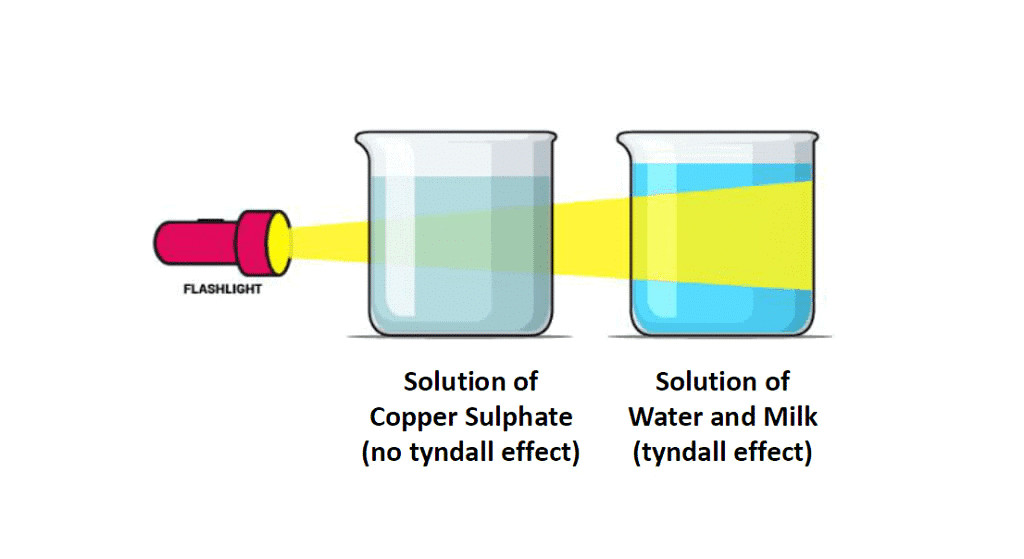 Solution of Copper Sulphate does not show Tyndall Effect, Mixture of Water and Milk shows Tyndall Effect
Solution of Copper Sulphate does not show Tyndall Effect, Mixture of Water and Milk shows Tyndall Effect
Properties of colloidal solutions
- A colloidal solution is a heterogeneous mixture.
- The particles of a colloid cannot be seen with a naked eye.
- Colloidal particles scatter light.
- Colloidal particles do not settle down when left undisturbed.
- Colloidal particles cannot be separated from the mixture by the process of filtration.
Dispersed phase and dispersion medium
- These are the components of a colloidal solution.
- The solute-like component in a colloidal solution are dispersed phase and the solvent like component in a colloidal solution is dispersed medium.
Some common examples of colloids
Physical and Chemical changes
A change which occurs without a change in composition and chemical nature of the substance is called physical change.
- Here a change only in physical properties of the substance takes place.
- Properties like colour, hardness, rigidity, fluidity, density, melting point and boiling point are known as physical properties.
- Melting of ice or boiling of water is a physical change because ice, water and water vapours are chemically the same substance i.e., H20.
A change of materials into another, new materials with different properties and one or more than one new substances are formed is called chemical change.
- Burning is a chemical change.
- During this process, one substance reacts with another substance to undergo a change in chemical composition.
- During burning of candle, actually both physical and chemical changes take place.
- The physical change involves the melting of wax and the chemical change involves the burning of wax into carbon dioxide and water.

What are the Types of Pure Substances?
On the basis of their chemical composition, substances can be classified either as elements or compounds.
Elements
- Lavoisier, a French chemist defined an element as the basic form of matter that cannot be broken down into simpler substances by chemical reactions.
- Elements can be divided into the following main threetypes of substances:
- Metals.
- Non-metals.
- Metalloids.
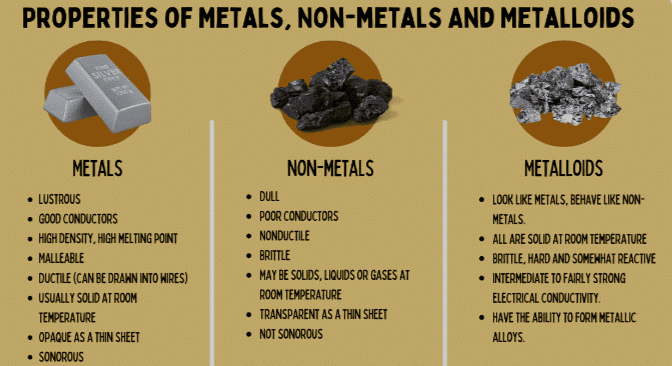 Metals show the following properties
Metals show the following properties
- They have a Lustre.
- They have silvery-grey or golden-yellow colour.
- They conduct heat and electricity.
- They are ductile that means they can be drawn into thin wires.
- They are malleable. That means they can be beaten into thin sheets.
- They are sonorous i.e., they make a ringing sound when hit.
- Examples of metals are gold, silver, copper, iron, sodium, etc.
Non-metals show the following properties
- They display a variety of colours.
- They are poor conductors of heat and electricity.
- They are not lustrous, sonorous or malleable.
- Examples of non-metals are oxygen, iodine, carbon, etc.
- Some elements have intermediate properties between those of metals and non-metals.
- They are called metalloids.
- Examples of metalloids are boron, silicon and germanium.
Some facts about elements
- The number of elements known at present is more than 100. Ninety two elements are naturally occurring and the rest are man-made.
- Majority of the elements are solids.
- Eleven elements are in gaseous state at room temperature.
- Two elements are liquid at room temperature - mercury and bromine.
- Elements gallium and cesium become liquid at a temperature slightly above room temperature (303 K).
Compounds
A compound is a substance composed of two or more elements chemically combined with one another in a fixed proportion.
Activity - Exploring the Properties of Iron and Sulphur Mixture.
Materials required: Crushed iron filings, sulphur, china dish, burner.
Procedure:
- Divide the class into two groups.
- Provide each group with 5 g of iron filings and 3 g of sulphur powder in a china dish.
Group I:
- Mix and crush iron filings and sulphur powder together.
Group II:
- Mix and crush iron filings and sulphur powder together.
- Heat the mixture strongly until it becomes red hot.
- Remove from flame and let the mixture cool down.
Both Groups:
- Check for magnetism in the material obtained by bringing a magnet near it.
- Compare the texture and color of the material obtained by both groups.
- Add carbon disulphide to one part of the material obtained, stir well, and filter.
- Add dilute sulphuric acid or dilute hydrochloric acid to another part of the material obtained. (Note: Teacher supervision is necessary for this activity).
- Perform all the above steps with iron and sulphur separately.
Observation:
Upon heating, iron and sulfur react chemically to form a compound. This compound has different properties from the original elements, indicating a chemical change. The mixture of iron and sulfur before heating shows the individual properties of both substances, but once heated, a new substance with distinct properties is created.Conclusion
- When iron and sulfur are mixed and heated:
- Group I demonstrates a physical change, resulting in a mixture with similar properties to the individual substances (iron and sulfur).
- Group II exhibits a chemical change, where iron and sulfur react to form a compound with different properties.
This experiment highlights the differences between physical and chemical changes, as well as the concepts of mixtures and compounds in chemistry.
Mixture
If we simply mix iron filings with powdered sulphur and grind them together (no heating), we. obtain a mixture.
Comparison between mixtures and compounds
Table: Mixtures and Compounds

- We can summarise the physical and chemical nature of matter as under:

Old NCERT
Separating components of a mixture
- Heterogeneous mixtures can be separated into their respective constituents by physical methods like handpicking, sieving, filtration etc.
Activity: Perform an activity to obtain coloured component (dye) from blue/ black ink.
Materials required:
Burner, tripod stand, beaker, water, watch glass, ink.
Procedure:
- Fill half the beaker with water.
- Put a watch glass on the mouth of the beaker (see the figure).
- Put a few drops of the ink on the watch glass.
- Start heating the beaker.
- Continue heating as the evaporation goes on and stop heating when you do not see further change on the watch glass.
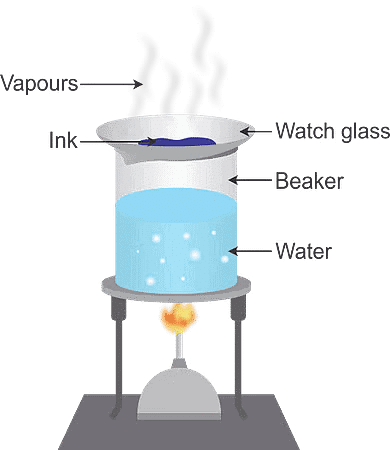 Ink separation using Evaporation Method
Ink separation using Evaporation Method
We observe that
- Water has evaporated from the watch glass. A residue of ink has been obtained on the watch glass.
- Ink could be a mixture of different components which can be seen and separated by chromatographic method.
Separation of cream from milk
- Cream can be separated from milk by the process of centrifugation which is done by centrifuging machine.
- This separation can also be achieved by using a milk churner.
- The principle of centrifugation is that the denser particles are forced to the bottom and lighter particles stay at the top when spun rapidly.
Applications of centrifugation
- Used in diagnostic laboratories for blood and urine tests.
- Used in dairies and at home to separate butter from cream.
- Used in washing machines to squeeze out water from wet clothes.
Activity: Separation of mixture of two immiscible liquids
- For the separation of a mixture of two immiscible liquids, we use a separating funnel as shown in the figure.
- Let us say we want to separate kerosene from water using a separating funnel. The following procedure is adopted:
- Pour the mixture of kerosene and water in a separating funnel.
- Let it stand undisturbed for some time so that the separate layers of kerosene and water are formed.
- Open the stopcock of the separating funnel and pour out the lower layer of water carefully.
- Close the stopcock of the separating funnel as the oil reaches the stopcock.
- The principle of separation by this method is that liquids separate out in layers depending on the densities.
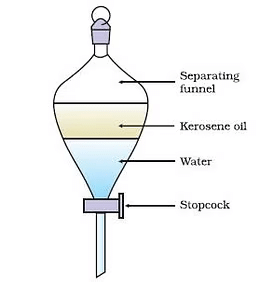 Separation of Immiscible Liquids
Separation of Immiscible Liquids
Separation of a mixture of salt and ammonium chloride
- We shall make use of the fact that ammonium chloride sublimes on heating whereas salt does not.
- This property of ammonium chloride is used in separating this mixture. The process is carried out using an inverted funnel.
Activity: To separate the mixture of salt and ammonium chloride
- Materials required : Burner, tripod stand, china dish, mixture, funnel, cotton plug.
- Procedure:
- Take about 5 g of the mixture on a clean china dish.
- Place it on a tripod stand and invert a glass funnel over it. Close the stem of the funnel with a cotton plug.
- Light a burner below the china dish. Keep a low flame.
- It will be observed that vapours of ammonium chloride are produced on heating which rise up the funnel.
- The vapours get cooled and deposit on the inner surface of the funnel.
- Salt is left in the china dish. Ammonium chloride can be obtained by scratching the inner wall of the funnel.
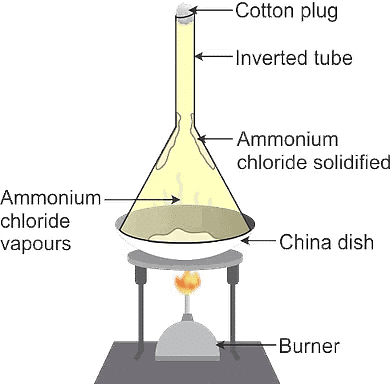 Separation of Common salt and Ammonium Chloride
Separation of Common salt and Ammonium Chloride
Separation of components of black ink
- It is amazing to know that black ink is not a single substance. It is a mixture of number of dyes which can be separated by a process known as chromatography.
Activity: To separate the components of black ink
Materials required: Strip of filter paper, pencil, ink, jar, water, glass rod, paper clips.
Procedure :
- Take a thin strip of filter paper.
- Draw a line on it using a pencil about 3 cm above the lower edge.
- Put a small drop of ink at the centre of the line; Let it dry.
- Lower the filter paper into a jar containing water such that the drop of ink on the paper is just above the water
- Leave it undisturbed for an hour.

Separation of Dyes in Black Ink using Chromatography
- It will be observed that components of the ink will rise up the filter paper strip in the form of spots of different colours at different heights.
- Thus, we shall be able to identify and separate different constituents of black ink.
- As water rises on the filter paper, it takes along with it the dye particles.
- The coloured component which is more soluble in the water rises faster.
- In this way, the colours get separated.
Application of chromatography:
To separate
- Colours in a dye
- Pigments from natural colours
- Drugs from blood
Separation of a mixture of two miscible liquids
- Components of a mixture of two miscible liquids can be separated by using the technique of distillation.
Activity: Perform an activity to separate the components of a mixture of two miscible liquids.
Materials required : Clamp, distillation flask, tripod stand, burner, thermometer, rubber corks, water condenser, beaker.
Procedure
- Let us separate a mixture of immiscible liquids acetone and water
- Take the mixture in a distillation flask. Fit it with a thermometer.
- Set up the apparatus as shown in figure below.
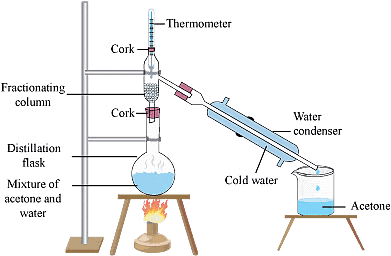 Separation of two Miscible Liquids by Distillation
Separation of two Miscible Liquids by Distillation
- Heat the mixture slowly keeping a close watch at the thermometer.
- Acetone, being more volatile, vaporises first, condenses in the condenser and gets collected in the beaker as shown in the figure.
- Water is left behind in the distillation flask.
- It will be observed that vapours of acetone are formed first because out of acetone and water, acetone is more volatile. Its boiling points (56°C) is lower than that of water (100°C).
- Thermometer reading becomes constant at 56 °C till the whole of acetone has vaporised.
- Boiling point of acetone is 56 °C.
- Acetone vapours cross over to the condenser where they condense into liquid acetone.
- This fraction is separated and collected in the beaker.
- Water is left in the distillation flask.
Fractional distillation
- When the difference in boiling points of the liquids that we wish to separate is less than 25 K, we may face problem with simple distillation technique.
- The more volatile liquid that we obtain in the beaker may be contaminated with less volatile liquid. In such cases fractional distillation is used.
Activity
- Here a fractionating column, as shown in figure below, is used. A simple fractionating column is a tube packed with glass beads.
- The beads provide surface for the vapours to cool and condense repeatedly.
- Only the more volatile component will be able to cross over to the condenser.
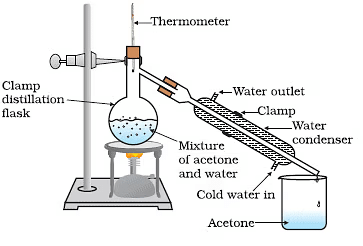 Fractional Distillation
Fractional Distillation
Separation of different gases of air
- Air is a homogeneous mixture of gases like nitrogen, oxygen, etc.
- The components can be separated by fractional distillation. The flow diagram of the process is given below:
 Flow Diagram of Separation of Components of Air
Flow Diagram of Separation of Components of Air
- Increasing order of boiling points of the gases is
Nitrogen < Argon < Oxygen
- As air is cooled, oxygen will form the liquid first as it has the highest boiling point.
The industrial plant used for the separation of components of air is shown in figure below: Separation of Components of Air
Separation of Components of Air
Crystallisation
This is a technique for the purification of solids.
Activity: Perform an activity to purify copper sulphate by the process of crystallisation
- Materials required: Impure copper sulphate, china dish, burner, filter paper, funnel.
- Procedure:
- Take approx. 5 g impure copper sulphate in a china dish.
- Dissolve it in minimum amount of water.
- Filter the impurities out.
- Evaporate water from the copper sulphate solution so as to get a saturated solution.
- Leave the china dish undisturbed for a day.
You will see crystals of copper sulphate in china dish. - We find that there are blue crystals of copper sulphate along with a liquid (called mother liquor) in the china dish.
- All the crystals look alike.
- The crystals can be separated from the liquid in the china dish by decantation.
Advantages of crystallisation over other techniques
Crystallisation technique of purification is recommended in the following cases:
- When solids decompose or get charred on heating.
- When we suspect some dissolved impurities in the filtrate.
Applications of crystallisation
- Purification of salt that we get from seawater. Separation of crystals of alum (phitkari) from impure sample.
Flow diagram of water purification system in water works
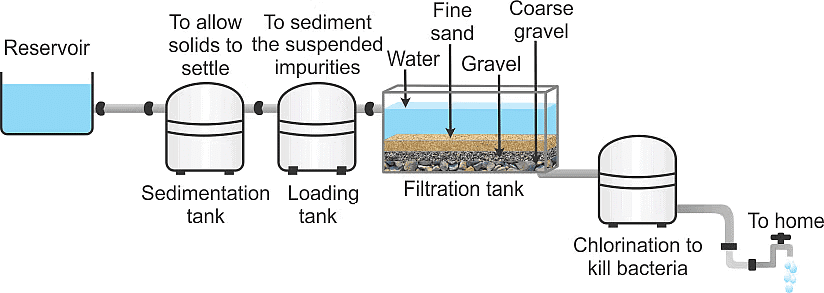 Process of Water Purification in Water Works
Process of Water Purification in Water Works
|
90 videos|490 docs|209 tests
|
FAQs on NCERT Summary: Is Matter Around Us Pure - Science & Technology for UPSC CSE
| 1. What is the difference between a solution and a suspension? |  |
| 2. Can you give examples of colloidal solutions? |  |
| 3. What are the physical and chemical changes in matter? |  |
| 4. What are the types of pure substances? |  |
| 5. How do mixtures differ from pure substances? |  |




















